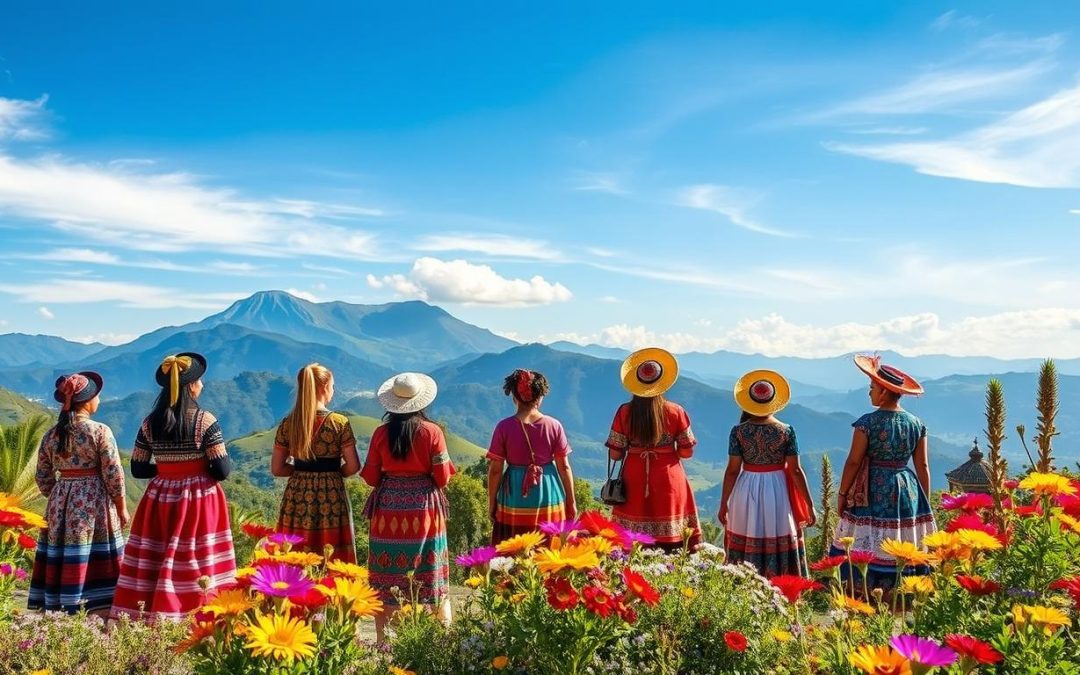Have you ever wondered how a small Central American country can host such a remarkable linguistic tapestry? Guatemala is a stunning example of how Spanish and indigenous languages can live together in harmony.
In Guatemala, language is more than just a way to communicate. It’s a deep connection to the country’s cultural heritage. Spanish is the official language, spoken by 93% of the people. But, the country also has 24 distinct indigenous languages, showing the strength of its cultural roots.
Exploring Guatemala’s languages takes you on a journey of survival, identity, and communication. From big cities to small villages, languages like K’iche’, Q’eqchi’, and Kaqchikel create a rich cultural tapestry. This tapestry is what makes Guatemala truly unique.
Key Takeaways
- Spanish is the official language of Guatemala, spoken by 93% of the population
- Guatemala recognizes 24 indigenous languages officially
- K’iche’ is the most prominent Mayan language with 1 million speakers
- Indigenous languages represent critical cultural heritage
- Linguistic diversity reflects Guatemala’s complex historical background
Guatemala’s Linguistic Landscape Overview
Guatemala has a rich linguistic landscape that shows its deep cultural roots and history. The country’s language diversity is a mix of Spanish and indigenous languages. These languages tell stories of resilience and cultural identity.
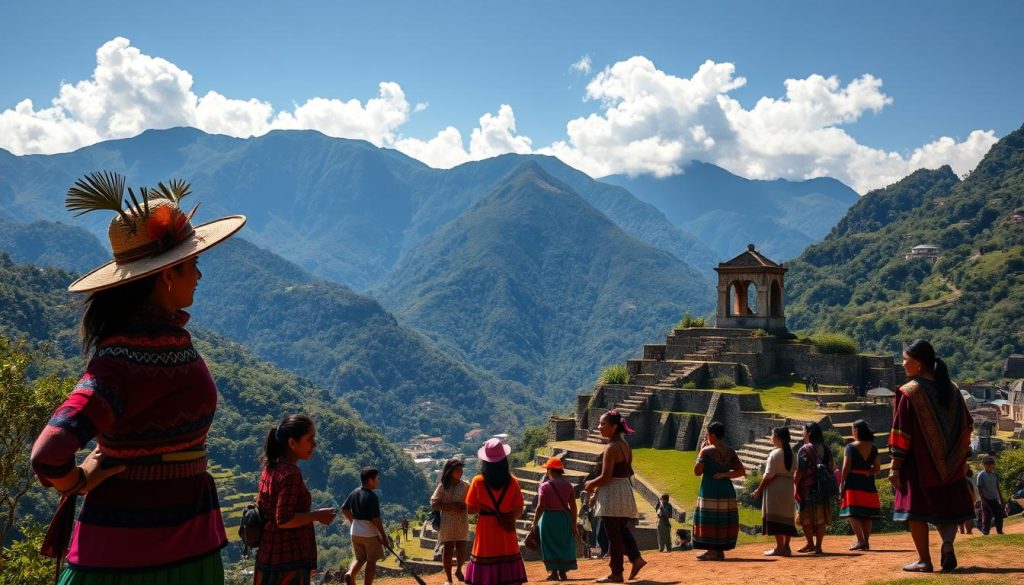
The Mayan languages are at the heart of Guatemala’s linguistic heritage. These indigenous communication systems have survived for centuries. Today, about 21 Mayan languages are officially recognized in the country, making it a unique linguistic ecosystem.
Language Distribution Dynamics
Spanish is the official language and the main way people communicate, spoken by 93% of the population. Yet, indigenous languages are key to Guatemala’s cultural identity. Let’s dive into the linguistic landscape with a detailed breakdown:
| Language Group | Speakers | Region |
|---|---|---|
| K’iche’ | 2.3 million | Western Highlands |
| Q’eqchi’ | 800,000 | Northern Guatemala |
| Kaqchikel | 450,000 | Central Highlands |
| Spanish | 16 million | Nationwide |
Historical Language Development
Guatemala’s linguistic journey started with the Mayan civilization. The Language Law of 2003 was a key moment. It recognized Mayan, Xinca, and Garifuna languages as national languages. This law was a big step towards preserving linguistic diversity.
“Language is the roadmap of a culture. It tells you where its people come from and where they are going.” – Rita Mae Brown
Indigenous languages are crucial for Guatemala’s cultural preservation. They are used in classrooms and community gatherings. These languages keep the nation’s rich heritage alive.
- K’iche’ is the most prominent Mayan language
- Q’eqchi’ has more speakers than before
- Bilingual education programs help preserve languages
Guatemala’s linguistic landscape is complex and dynamic. Spanish and indigenous languages coexist, each adding to the nation’s unique cultural identity.
The Role of Spanish in Modern Guatemala
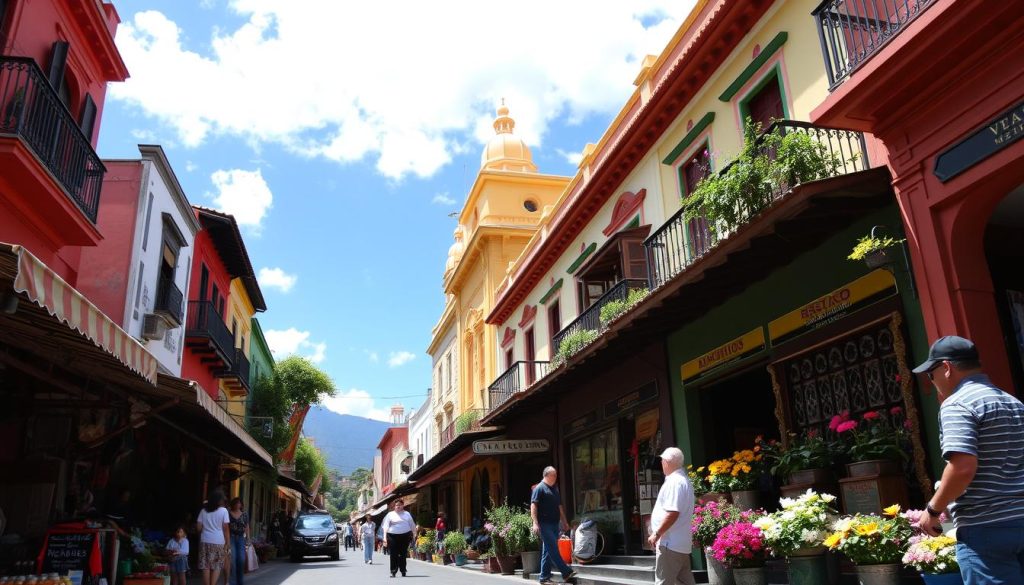
Spanish is key in Guatemala’s social and cultural scene. It’s the official language, linking the country’s varied communities. It’s the main way people communicate for about 93% of the population. Knowing how Spanish affects daily life is a good start.
Spanish’s importance goes beyond talking. In cities like Guatemala City, 97% of people speak it. This shows how Spanish has shaped the country’s history.
- Official language of Guatemala
- Spoken by 93% of the population
- Primary language in government and education
- Key communication tool across ethnic groups
Guatemalan Spanish has its own special traits. It mixes in words from indigenous languages, making it unique. Experts say over 10% of Spanish words here come from these roots. This shows how cultures blend together.
“Language is the roadmap of a culture. It tells you where its people come from and where they are going.” – Rita Mae Brown
Even though Spanish is the main language, Guatemala is also multilingual. About 40% of people speak both Spanish and an indigenous language. This shows the country’s rich language diversity.
Seeing Spanish in Guatemala means it’s more than a language. It’s a way to bring people together and keep the country’s culture alive.
Major Mayan Languages in Guatemala
Guatemala is home to 22 Mayan languages, each a colorful thread in the country’s tapestry. These languages are more than just a way to talk. They are symbols of indigenous identity and strength.
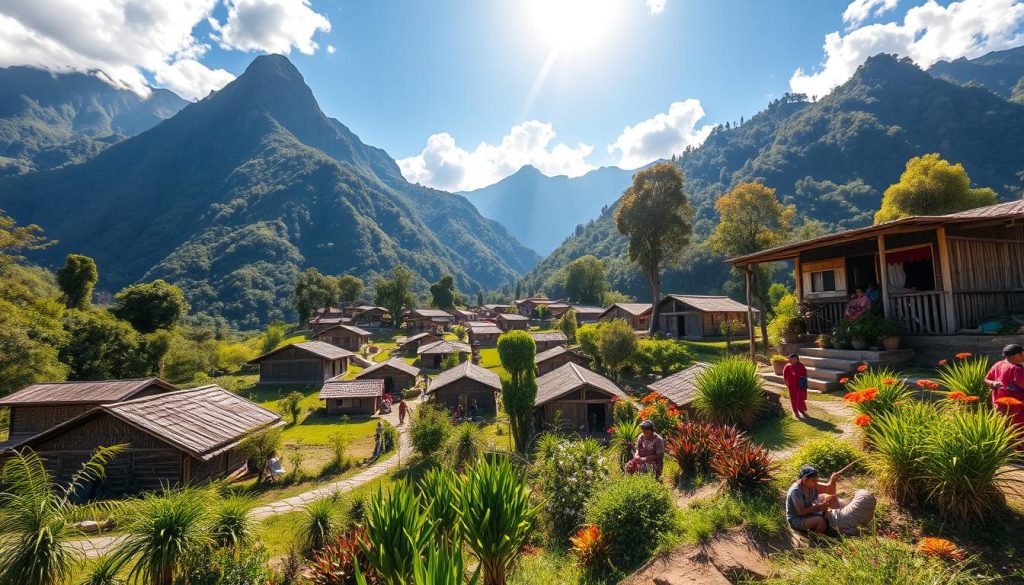
Exploring the major Mayan languages in Guatemala reveals the country’s rich linguistic diversity. Let’s dive into the key languages that define Guatemala’s culture.
K’iche’: The Linguistic Powerhouse
K’iche’ is the most spoken Mayan language in Guatemala. It has nearly 1 million speakers across 65 municipalities. This language is crucial, as it preserves the Popol Vuh, a key text of Mayan history.
- Spoken by approximately 11.31% of the population
- Widely used in western and central Guatemala
- Crucial for preserving indigenous cultural heritage
Q’eqchi’: Regional Linguistic Influence
Q’eqchi’ is another vital Mayan language with a big impact. It’s mainly spoken in Alta Verapaz and El Petén. This language keeps indigenous communities connected and their traditions alive.
- Represents 7.58% of Guatemala’s population
- Strong presence in northern departments
- Vital for intercommunity communication
Kaqchikel: Central Highlands’ Linguistic Treasure
Kaqchikel is a treasure in Guatemala’s Central Highlands. It plays a key role in bilingual education. With about 500,000 speakers, it’s a main way to express culture.
- Spoken by 7.41% of the population
- Concentrated in central mountainous regions
- Essential for preserving indigenous educational practices
“Languages are the roadmaps of a culture. They tell you where its people come from and where they are going.” – Rita Mae Brown
| Mayan Language | Speakers | Primary Regions |
|---|---|---|
| K’iche’ | ~1 million | Western & Central Guatemala |
| Q’eqchi’ | 7.58% population | Alta Verapaz, El Petén |
| Kaqchikel | 500,000 | Central Highlands |
Guatemala: Official and Widely Spoken Languages
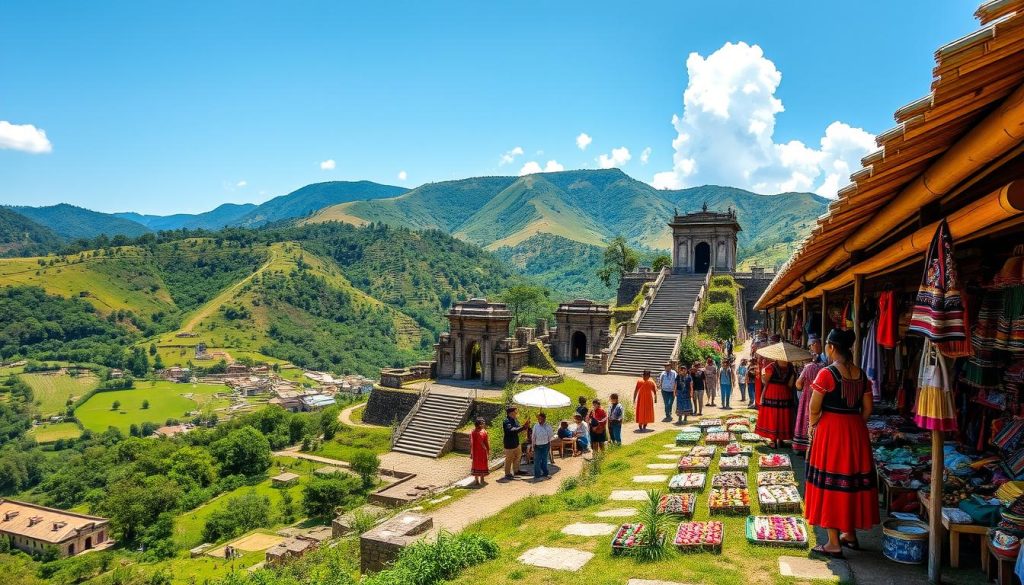
Guatemala is a vibrant multilingual nation. Spanish is the official language, spoken by 93% of the people. But the country’s language scene goes far beyond Spanish.
The linguistic diversity in Guatemala is amazing. The country has 25 languages, showing a rich cultural heritage. This includes:
- Spanish (official language)
- 22 distinct Mayan languages
- Xinca language
- Garifuna language
Some indigenous languages have a lot of speakers:
- Kʼicheʼ: About 1,000,000 speakers (5.79% of population)
- Q’eqchi’: Around 555,461 speakers (3.22%)
- Kaqchikel: Roughly 500,000 speakers (2.90%)
- Mam: About 480,000 speakers (2.78%)
“Language is the roadmap of a culture. It tells you where its people come from and where they are going.” – Rita Mae Brown
In cities, Spanish is the main language. But in rural areas, indigenous languages are key. About 40% of Guatemalans speak an Amerindian language. This shows the nation’s effort to keep languages and cultures alive.
Guatemala values its diverse language roots. It balances official language use with respect for indigenous languages.
Indigenous Language Communities
Guatemala’s language scene is a colorful mix of indigenous tongues. These languages show the nation’s rich cultural roots. With 23 different indigenous languages, the Mayan languages are a key part of Guatemala’s heritage.
Traditional Language Territories
Guatemala’s indigenous languages are tied to specific areas. Each Mayan language has its own territory:
- K’iche’ dominates the central highlands
- Q’eqchi’ is prevalent in northern regions
- Kaqchikel thrives in central Guatemala
Cultural Significance
These languages are more than just ways to talk. They hold cultural knowledge, ancient wisdom, spiritual practices, and community memories. They are a vital link to Guatemala’s history.
“Language is the roadmap of a culture. It tells you where its people come from and where they are going.” – Rita Mae Brown
Modern Usage Patterns
Despite obstacles, indigenous languages are still alive. While 93% of Guatemalans speak Spanish, the younger crowd is proud of their native tongues. They see them as symbols of cultural pride and resistance.
| Language | Speakers | Primary Regions |
|---|---|---|
| K’iche’ | 1.2 million | Central Highlands |
| Q’eqchi’ | 800,000 | Northern Guatemala |
| Kaqchikel | 400,000 | Central Guatemala |
Language Education and Policy
Guatemala values its rich cultural mix in language education. As a multilingual nation, it has created policies to support and celebrate indigenous languages in schools.
The Language Law of 2003 was a big step for Guatemala’s language diversity. It recognized 24 indigenous languages and Spanish, setting the stage for inclusive education.
“Language is the roadmap of a culture. It tells you where its people come from and where they are going.” – Rita Mae Brown
Guatemala’s language education policy focuses on:
- Intercultural Bilingual Education (IBE) programs
- Indigenous languages as national languages
- Bringing cultural diversity into classrooms
Yet, the education system faces challenges. Only 50% of indigenous kids go to school, unlike two-thirds of non-indigenous ones. Indigenous workers have much lower education, averaging 1.6 years compared to five for others.
The government keeps pushing for language preservation. The Intercultural Bilingual Education model tries to close cultural and language gaps. It ensures Guatemala’s indigenous heritage stays alive and valued in schools.
Preserving linguistic diversity is not just about language – it’s about maintaining cultural identity and empowering indigenous communities.
Challenges in Language Preservation
Guatemala’s linguistic diversity is facing big challenges. The Mayan languages are at risk of disappearing. Several languages are close to being lost forever.
Endangered Languages: A Delicate Linguistic Ecosystem
The language situation in Guatemala is very concerning. Out of 22 Mayan languages, five are in danger. The Itza’ language has only 123 speakers, showing how fragile languages can be.
- Languages at highest risk: Itza’, Mopan, Ch’orti’, Sipakapense, and Tektiteko
- Total indigenous languages in Guatemala: 25
- Percentage of endangered languages: Approximately 20%
Preservation Efforts: Protecting Linguistic Heritage
New ways are being tried to save languages. Technology and community efforts are helping document and revive languages.
| Preservation Strategy | Key Focus |
|---|---|
| Digital Documentation | Creating online resources and learning platforms |
| Bilingual Education | Integrating indigenous languages in school curricula |
| Community Workshops | Engaging younger generations in language learning |
Community Initiatives: Grassroots Language Revival
Local communities are leading the fight to save their languages. They are teaching younger people to speak their languages. This way, their languages can keep living.
“Language is the roadmap of a culture. It tells you where its people come from and where they are going.” – Rita Mae Brown
Your help and awareness can really help protect these languages. It’s important to keep Guatemala’s rich language heritage alive.
Impact of Multilingualism on Guatemalan Society
Guatemala’s many languages deeply shape its society. This creates a rich mix of cultures and ways of talking. Being a multilingual nation, Guatemala sees special effects on education, friendships, and identity.
The variety of languages in Guatemala goes beyond just talking. With 24 different languages, the country is a complex place of cultural expression. Indigenous languages mix with Spanish, forming complex social networks that show the nation’s deep cultural history.
- 43.75% of Guatemala’s population identifies as indigenous
- Approximately 24 distinct language communities coexist
- Multiple language groups contribute to national social dynamics
Language use in Guatemala shows great benefits for thinking and social skills. Switching between Spanish and languages like K’iche’ or Q’eqchi’ is a smart way to talk. This skill helps understand culture better and makes social talks more detailed.
| Language Group | Estimated Speakers | Primary Region |
|---|---|---|
| K’iche’ | 1 million+ | Central Highlands |
| Q’eqchi’ | 500,000+ | Northern Guatemala |
| Kaqchikel | 400,000+ | Central Regions |
Education systems now see the value of many languages. Programs that teach both Spanish and indigenous languages help keep these languages alive. These efforts are key to keeping Guatemala’s rich language history alive.
“Language is the roadmap of a culture. It tells you where its people come from and where they are going.” – Rita Mae Brown
By accepting many languages, Guatemala turns what could be tough into chances for cultural sharing and understanding.
Conclusion
Your journey through Guatemala’s languages shows a colorful mix that reflects its rich culture. Spanish is the official language, bringing the country together. But, indigenous languages keep the roots of Guatemalan identity alive.
Guatemala has 23 official languages, including 21 Mayan ones. This shows the country’s complex cultural history. It’s a testament to its rich heritage.
Keeping indigenous languages alive is crucial. It connects people to their cultural past. Languages like K’iche’ and Kaqchikel show the strength of Guatemala’s indigenous people.
Despite challenges, these languages are still thriving. People work hard to keep their unique voices alive.
Guatemala’s future depends on balancing Spanish and indigenous languages. This diversity is not just history. It’s a living part of the nation’s identity.
Understanding Guatemala’s languages opens a window to its soul. Each language has its own story and history. Guatemala stands out in Central America for its cultural and linguistic richness.
The above is subject to change.
Check back often to TRAVEL.COM for the latest travel tips and deals.
Here are some Tours & Sightseeing suggestions that might pique your interests!
